
Here are a few tips and tricks which could give you an advantage over your mates when it comes to using soft plastics on trout!
Use a loop knot
Using a loop knot tied to the end of your Strike Tiger jig head will ensure that your soft plastic is able to move freely, thereby maximising its effectiveness.
To tie it, try this:
Step 1 - Form a loop at the end of the line by passing the tag end behind the standing line.
Step 2 - Take a turn around the standing line, forming a second loop. Hold in place and take another turn around the line, this time crossing on the topside of the new loop.
Step 3 - Hold the tag end in place and pass the loop through the first loop.
Step 4. – Pull the loop up until the knot jams tight.
Step 5. - Trim the tag end and you’re done.

Pimp your jig heads
This is a trick that many professional bream tournament anglers use. The term ‘pimping’ simply means enhancing the appearance of your lures. In order to get the most realistic presentation possible, you can easily paint jig heads to suit your soft plastics. Clear and/or coloured nail polish is a suitable and inexpensive product for this task. You also may want to add some realistic looking Strike Tiger red, amphibian or natural coloured lure eyes. Eyes that are 3mm in diameter are generally suitable for most jig head applications.
Once you have stuck the eyes on the jig head, you should coat them with a layer of clear nail polish. This will give your jig head a professional finish, but more importantly, the eyes will be less likely to come off. You may think that it is a fiddly process – but so is fly tying! Once you have seen the final product, I am sure that you will agree that taking the time to add a little extra detail will result in an enhanced soft plastic presentation. This can definitely make your offering more appealing to trout, which is of course the aim. Just make sure that, unless you are purchasing your own supplies, you ask permission before using nail polish belonging to your wife, girlfriend or mum!
Target weed beds
How many times have you been trout fishing and hooked up on weed? Whether you are trolling or casting soft plastics, the weedy encounter is a common occurrence that every one of us can relate to. In saying this, tangling with weeds can also result in some nice trout catches. I have had this happen to me on many fishing trips. You may be familiar with this yourself - retrieving a lure that has snagged, only to have it smashed by a thumping great big trout just after it gets free from the weed.
Finding weed beds in a lake is easy with the help of a sounder fitted to your boat or kayak. Any seasoned angler that has been fishing a favourite water will probably already know where they are anyway. Once you find the weed beds, target the water between the surface and the top of the weed with soft plastics.
A soft plastic creature bait is well-suited for this method. Plastics that remotely resemble some type of insect or crustacean are my pick. For this method you can't go past the Strike Tiger 1 inch nymph. The Strike Tiger 1.8 inch mudeye and Strike Tiger 2 inch bug are also good choices. The trout will particularly like anything that has legs or tentacles that pulsate! I use a retrieve that has a quick succession of short, but subtle twitches of the rod tip. An ‘inch flick’ of the rod tip either way as you are doing this is perfect. Next, give the plastic a brief pause – a second, if that. Then repeat the sequence over again until it clears the weed. It is important that you do not retrieve too fast.
The short succession of twitches will get the legs and any dangly bits of the creature bait really pulsating through the water. This makes the lure look very realistic and alive. The added movement of the legs will also send ‘fish attracting vibrations’ through the water. Lastly, don’t forget to be prepared for a strike. It is important to anticipate this, particularly on the pause sequence. This is because trout will often find the lure an easy target when it ‘slows’ or appears ‘dead’. Unfortunately, I have lost too many good fish because I wasn’t giving the retrieve my full attention - so it pays to concentrate and be alert at all times.
Target wind-blown shores
Fishing wind-blown shorelines with plastics is a proven trout catching method. It's especially affective for late in the season. The constant pounding of the waves against the shore works to stir up the natural bait – a bonus for us anglers! Galaxias, one of the items on a trout’s menu, are little fish that spawn on the rocky shorelines of many Tasmanian lakes. If conditions are fierce enough, the waves crashing against the shoreline can actually kill many of them. Of the ones that survive, some will be temporarily ‘stunned’, resulting in erratic and impaired swimming actions. Trout will patrol such shorelines, chasing the live galaxias. They will also happily take the opportunity to get an easy meal, mopping up any dead galaxias that have been slammed against the rocks by the waves. Suitable plastics for this tactic include the Strike Tiger 3 inch minnow and the Strike Tiger t-tail (in both the 2 and 2.5 inch versions).
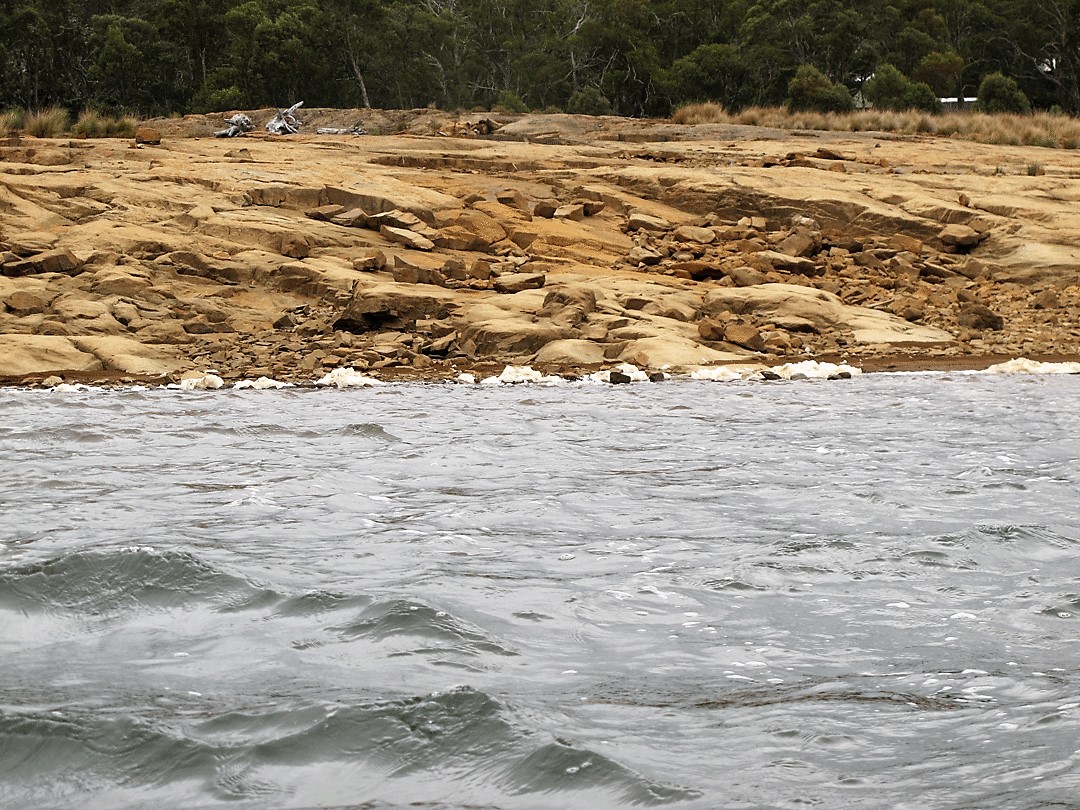
(Above: a typical 'wind-blown' shore - note the foam build-up.)
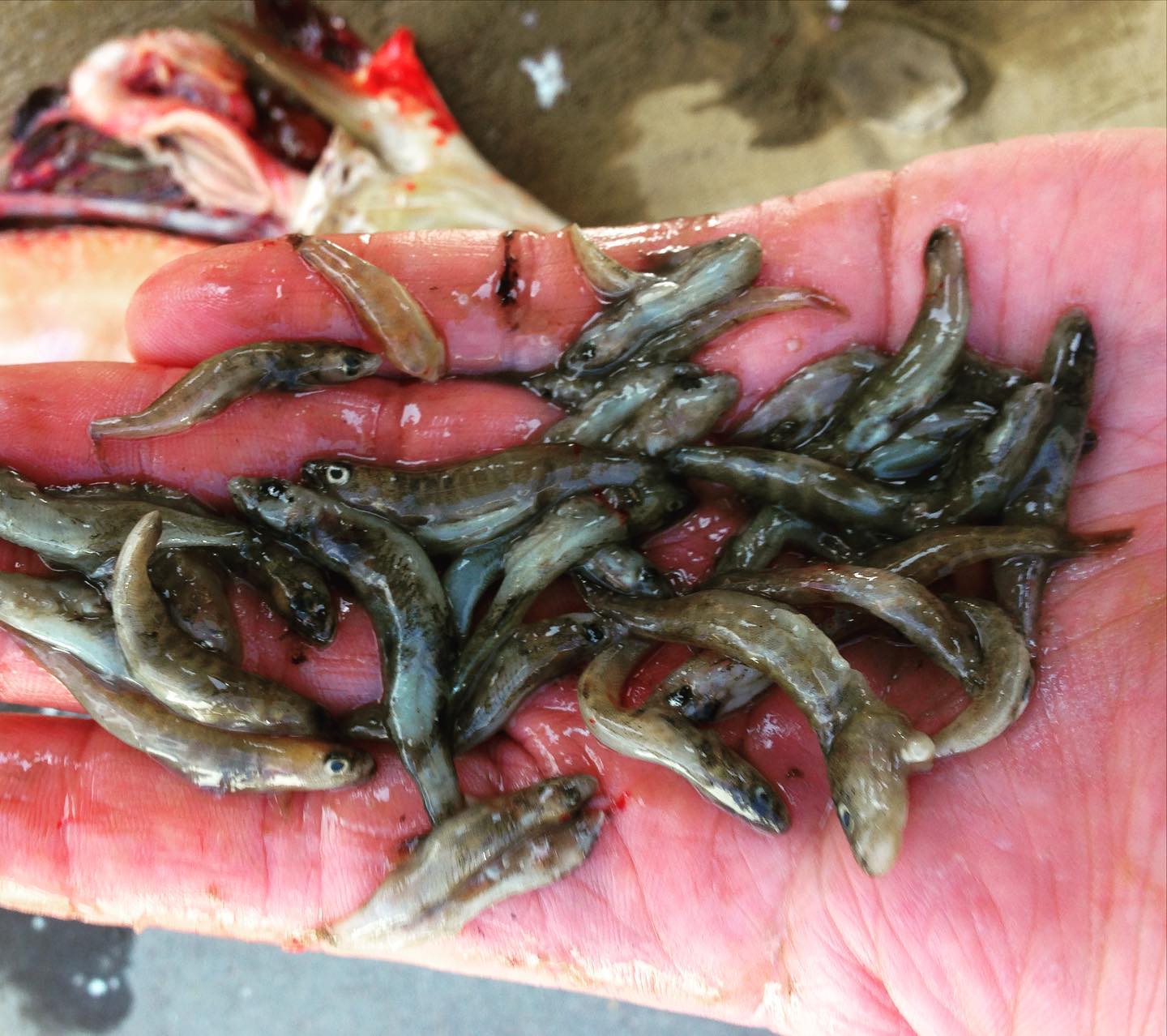
(Above: Tasmanian Great Lake 'galaxia' removed from a brown trout's stomach.)
Target structure
Structure provides trout with safe hiding places. Think of those dead trees sticking out of the water in a lot of our lakes. They are all potential trout holding areas that should never be overlooked. When targeting timber structures, accurate casts right up against the timber are important. Let the plastic flutter down hard against the target and don’t forget to anticipate any strikes as it sinks. Time and effort at these locations is usually well rewarded.
Structure is not just limited to timber. Weed beds are another great area to target. They normally hold good amounts of ‘trout tucker’, as well as providing the trout with cover and concealment. As the saying goes, ‘where there is food, there is fish’, and this is certainly true for weed beds. Although, great fishing spots, they are located sub-surface and can take some finding if your boat does not have a sounder.
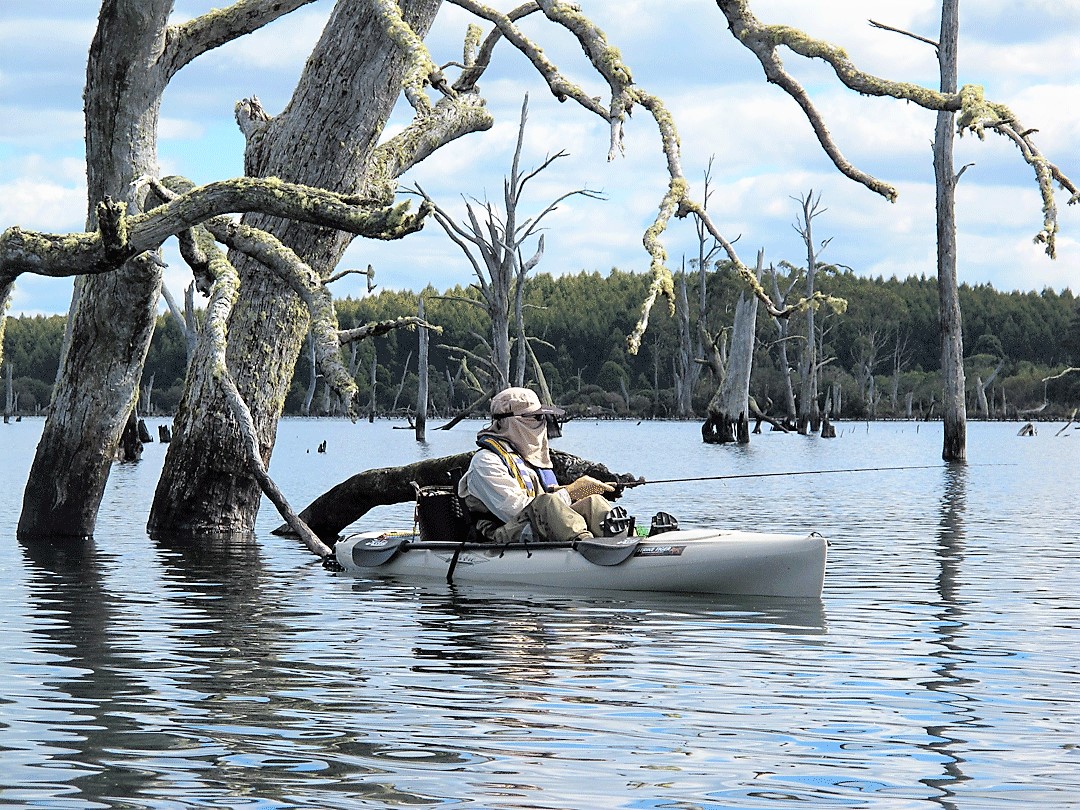
(Above: a kayak can get you right in close to where the trout are holding)
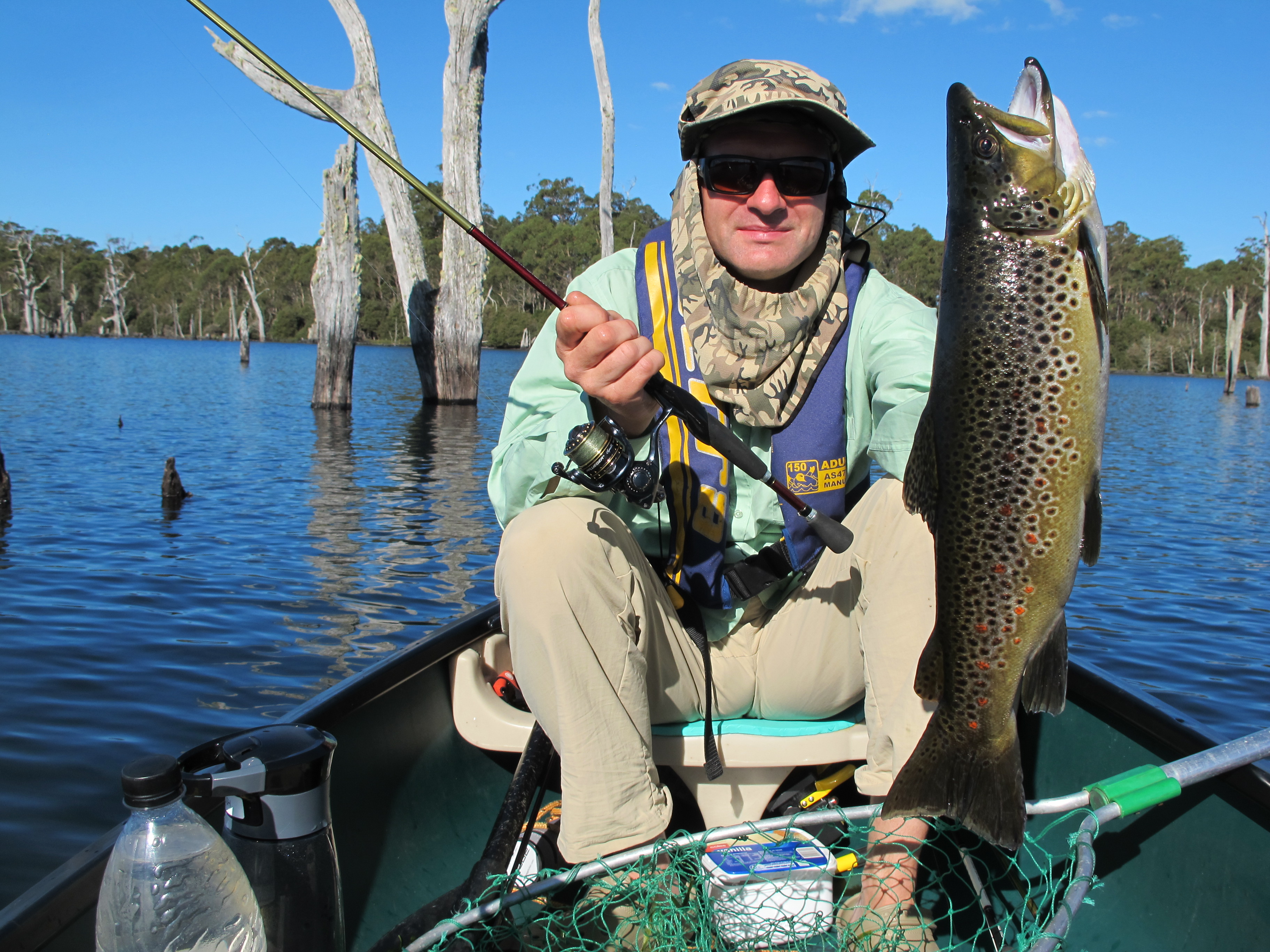
(Above: a trophy sized Tasmanian brown trout caught in the dead timber on a Strike Tiger 2" t-tail soft plastic.)
A couple of good soft plastic retrieves
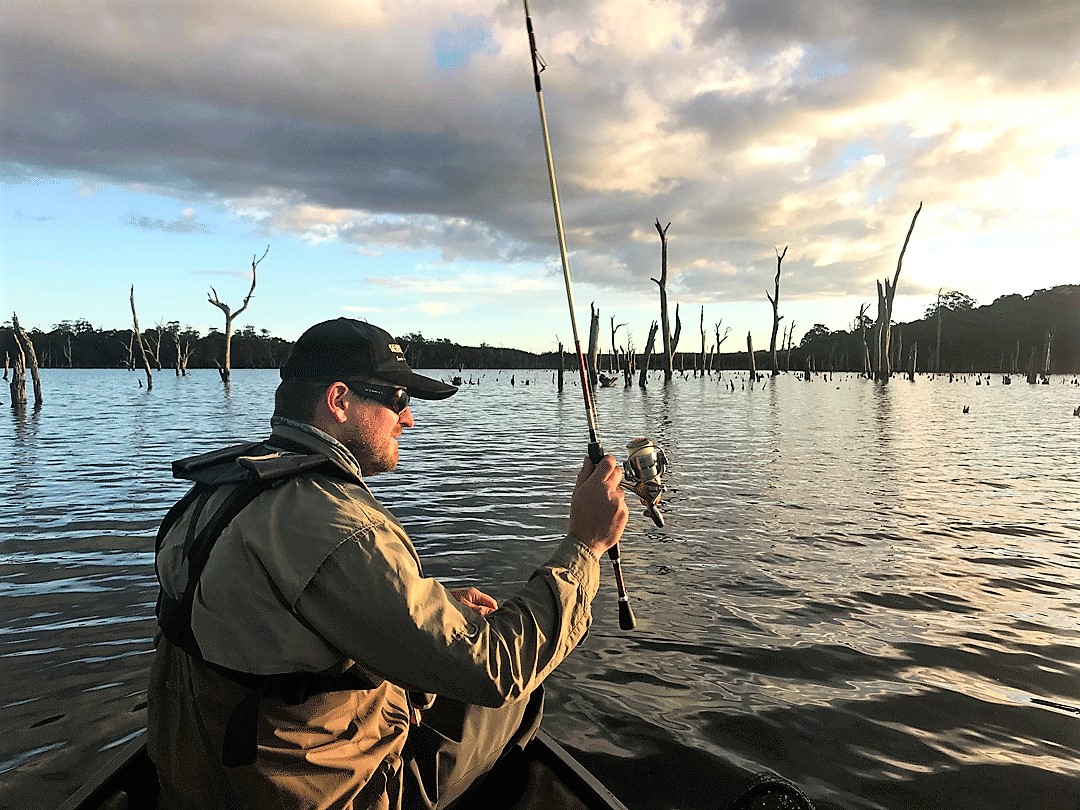
‘The Lift & Drop’
This one works very well for mid to deep sections of water, because the plastic is able to travel a considerable distance as it swims to the surface and then naturally flutters to the bottom.
The technique is exactly as it sounds. Cast your plastic, let it sink, then lift and drop. Wind slowly as you drop to take up the slack line, and then repeat. It is as simple as that! If you get no interest using this technique, then incorporate some fast and slow twitches into the lift part of the retrieve. The key here is to only move your rod tip an inch or two either way. If you move it any further, your soft plastic may not swim naturally.
This retrieve is very easy to master and will work with all Strike Tiger soft plastics.
‘The Rip & Pause”
This method is well suited to fishing those wind-blown shorelines. If you are fishing these areas, you will likely be fishing shallow. So, as soon as your plastic hits the water, wind as fast as you can for 2 or 3 sharp turns of your reel. Be sure to hold your rod-tip high, as this will ensure that your plastic will swim shallow right from the start. If you are fishing deeper water, just remember to let the plastic sink a bit first. You will also need to hold your rod tip lower.
The next step is to pause. This allows the plastic to sink for a second or so. Repeat the rip, and then pause again. As you progress the plastic into deeper water, hold the rod tip lower to allow it to dive deeper. You will also need to increase the number of times you turn the reel when you ‘rip’ the lure, as well as extending the pause time as you continue the retrieve.
I find that when using this method, I can trigger interest, and ultimately a reaction-bite, from trout that have ‘shut down’. You may also find that many strikes will be on the pause part of this particular retrieve. Anticipating this is therefore very important for successful hook-ups.
This retrieve is best suited to the Strike Tiger 3 inch minnow, but you can also try it using the Strike Tiger 1 inch nymph when action is slow.
Sometimes a slower retrieve is better
The key to any type of fishing, whether it be soft plastic or hard body lure based, is finding a retrieve that will work for you on the day. Trout are funny creatures that respond to different retrieves on different days. If they are shut down, try slowing your retrieve right down. This is a tactic that often works for me.
Try this:
‘slow roll’
Slow rolling a soft plastic is exactly as it sounds. This is an easy retrieve where you slowly, but constantly retrieve your plastic along the bottom or at your chosen diving depth. It will work in lakes, rivers and even small creeks. With an inbuilt tail action, Strike Tiger grubs, t-tails and minnow soft plastics are perfect choices for this technique.
Start out by casting your plastic and letting it sink to the bottom. You will know the plastic is on the bottom by watching your line – as soon as it goes slack, you are there. Next, lift your rod tip slightly. It’s now just a matter of winding the lure back ever so slowly. You should feel the plastic touch the bottom every now and then. If the action is slow – try throwing in a few pauses. Extend the time you pause the lure for in order to give the trout some extra time to observe the offering.
‘slow twitch’
Again, this technique is fairly self-explanatory. It is particularly well suited to small creature baits such as the Strike Tiger 1 inch nymph. Start off exactly the same as per the ‘slow roll’ – cast out and let the plastic sink to the bottom. Next, slowly ‘twitch’ the plastic along the bottom while winding very slowly. Do this by applying short, but subtle twitches of your rod tip as you wind in. Aim to move your rod tip back and forth only a couple of inches.
By doing this, you will impart a very realistic swim action to the soft plastic. Creature baits rigged on a weightless hook using the simple ‘split-shot’ method work very well with this technique (crimp the split shot approximately 40 cm up from the plastic). In a lot of cases, the split shot will bounce along the bottom and the creature bait will suspend a short distance above. This presentation is representative of food sources found on the bottom, and it is a killer technique in both lakes and rivers!
Conclusion
So, there are just a few of my tips that should help you bag a few trout.
Being prepared with jig heads that set your plastics above the rest may just be the advantage you need to out fish your mates. Seek out those weed beds, because that’s where the fish will be hiding. Look for dead timber too!
If the trout aren’t interested in your plastics, don’t be afraid to slow your retrieve right down. Mix it up and I am sure that you will find a technique that works for you on the day.
Stay safe out there and good luck!
